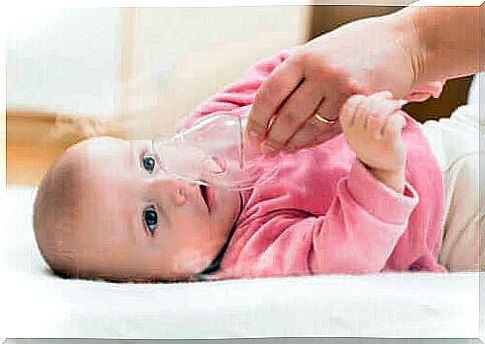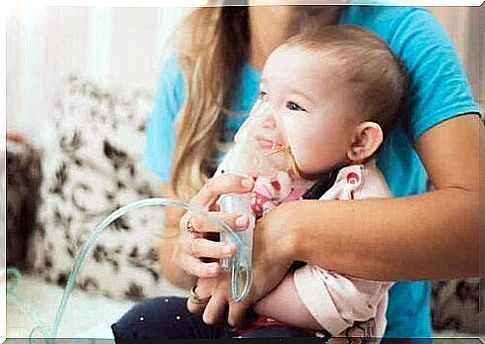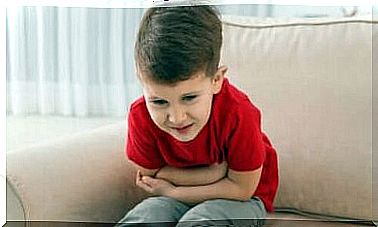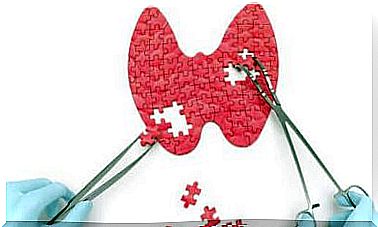Bronchiolitis: Causes, Symptoms And Treatment

Acute bronchiolitis (AB) is a common disease in children. The worldwide annual incidence is about 10%. In other words, every year one in ten children under the age of two will develop this condition. In addition, it is the most common cause of hospital admissions for respiratory infections in this age group (1-5%).
Although there is no medical consensus on the definition of bronchiolitis, it is most commonly associated with episodes of difficulty breathing or a whistling sound when breathing, preceded by the symptoms of a cold. If you want to know everything about bronchiolitis, we encourage you to read on.
The causes of bronchiolitis

According to the United States National Library of Medicine , bronchiolitis is a common lung infection in small children. From a clinical point of view, it is characterized by the accumulation of mucus in the small airways of the lungs (bronchioles). It is usually caused by a virus.
According to the journal Pediatría Integral (Spanish link), bronchiolitis occurs in epidemics in winter and early spring. The most affected population is young children between the ages of three and six months. Below we list some of the most common causes.
1. Respiratory syncytial virus (RSV)
A negative single-stranded RNA virus of the paramyxovirus family (Paramyxoviridae) causes 56% of bronchiolitis cases requiring hospitalization. It is widespread all over the world. In fact, experts estimate that almost all children in the world suffer from it before they turn four.
2. Rhinovirus
This is a genus of viruses in the family Picornaviridae. They are the most common cause of infections in humans and they cause the common cold. More than 110 serological types can cause various symptoms. Although less common than RSVs, rhinoviruses can also cause bronchiolitis in infants.
3. Human Parainfluenza Virus Type 3 (HPIV3)
The MSD manual portal states that parainfluenza viruses are classified into four types (Spanish link). While type 3 causes most cases of bronchiolitis, types 1 and 2 can also cause it. Infections caused by parainfluenza are indistinguishable from infections caused by RSV. However, they are usually less severe.
Risk Factors
While bronchiolitis can affect any child, it is much more common in breastfed and immunocompromised children. As the KidsHealth portal points out, some of the most common risk factors include:
- Being a baby or young child. Their noses and airways are much more fragile than those of adults. Their bronchioles are shorter and smaller in diameter. So, when there is swelling, the chances of problems are much higher.
- Being a premature baby.
- Children with compromised immune systems or concurrent lung or cardiovascular disease.
- Exposure to tobacco smoke, repeated residence in environments where there are many children and exposure to certain toxic chemical compounds.
In general, age is the most relevant risk factor. As we mentioned above, about 70% of babies become infected with RSV in their first year of life. However, this does not mean that they will develop bronchiolitis: only 22% develop symptoms.
Symptoms of bronchiolitis
The United States National Library of Medicine has summarized the most common symptoms of bronchiolitis in children. However, not all children develop them. Some examples of the symptoms of bronchiolitis include:
- Difficulty breathing including wheezing and shortness of breath.
- Cough, fatigue and fever. These clinical signs, typical of a cold, precede bronchiolitis.
- The muscles around the ribs collapse as the child tries to inhale (called intercostal retractions). The child’s nostrils widen when breathing, as a way of trying to get more air.
- Rapid breathing (tachypnea).
Bronchiolitis usually manifests 24-48 hours after the previous clinical signs. The symptoms usually last 12 days. Up to 18% of affected infants have symptoms for 21 days and 9% of them for a month.
Possible complications

As the sources cited above state, severe loss of breathing capacity in newborns can be fatal. If your child has symptoms of bronchiolitis and you notice that the skin is bluish (cyanosis), see a doctor immediately. Cyanosis indicates a lack of oxygen.
Interruptions of breathing, dehydration and low oxygen levels in the blood are other clinical signs that indicate that the bronchiolitis is severe. In most cases, those symptoms only occur in premature babies or in children with other illnesses.
Treatment options
According to the specialized portal Neumoped, no drug can help to treat bronchiolitis (Spanish link). It is a viral disease that only the baby’s immune system can fight. Most cases are mild and do not require medical attention.
We must emphasize that treatment with antibiotics will be futile. In fact, this could worsen the clinical picture as it could amplify the bacterial strains present in the body. However, the treatment changes drastically in hospitalized children.
Hospital treatment
When a baby is admitted for bronchiolitis, doctors focus on helping to restore a normal breathing rhythm. To do this, they give oxygen (30-40%) through a nasal cannula or face mask to keep their oxygen saturation level at 90% or more. In the most severe cases, endotracheal intubation is required.
In addition, doctors also try to restore a natural water balance. For this, they administer oral rehydration solutions or, in the most severe cases, intravenous rehydration solutions.
Recommendations for treatment at home
Most cases of bronchiolitis are treated at home with patience and diligence. Although you cannot help your child fight the disease, you can control the symptoms with a series of very simple actions. These include the following advice:
- Keep your baby hydrated. Make sure your child gets plenty of water to avoid dehydration due to the disease.
- Do regular nasal rinses. You can buy over-the-counter medications for this from pharmacies that provide relief in both infants and adults. This makes it easier for the patient to breathe.
- Keep the child in a sitting position, even when sleeping. This promotes sufficient air movement, much better than if they were lying down.
- Use a humidifier. It’s a good idea to put a humidifier in your sick child’s room, especially when he’s sleeping. This softens the build-up of mucus and therefore helps to relieve the symptoms such as coughing and nasal congestion.
Bronchiolitis usually goes away on its own
As we have mentioned in this article, bronchiolitis is a very common disease in infants. So you don’t have to worry if your baby suffers from it. In most cases, the problem will resolve itself. So be patient and follow the home care guidelines to support your child.
In any case, if you notice any of the clinical signs we have listed above, you should take your child to the emergency room as soon as possible. If your child’s breathing capacity is affected, it can have major consequences.









